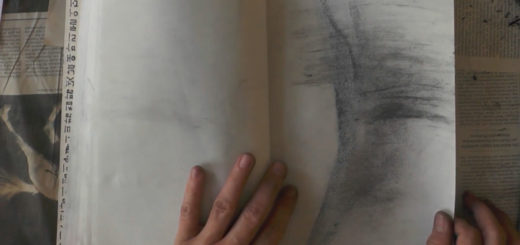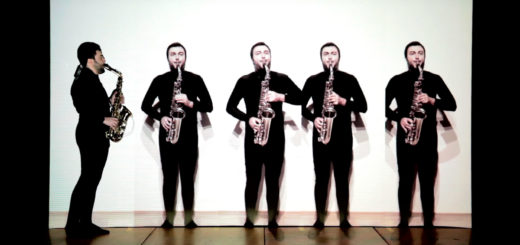Kosmas Giannoutakis: Timelife/Zeitleben
Timelife/Zeitleben. Game-piece for double bass and audiovisual computer system (2015)
“How much do we violate the nature of Time when we use spatial representations? Left is the past, center is the now and right is the future. Can a movement in the space provoke a disposition in time?”
The piece explores the notion of Time in a staged, live audiovisual performance. It is based on the idea of representation of Time (past-present-future) with spatial properties (left-center-right). The bassist stands and plays under the projection screen. His sound/image (referred as “shadow”) is recorded/captured by a microphone/camera and reproduced/projected by speakers/projector at the acoustic field of the concert hall/projection screen. His “shadow”, which is technically a synchronized audiovisual delay line, starts above him with zero delay time and moves to the left (“Past”) with a constant speed. As the “shadow” moves to the left, the delay time increases. A background video is projected showing a hand drawing a wavy line, pointing the “Now”.
Five “shadows” appear in the piece successively. With the insertion of a new, the old one(s) remain(s), creating a multi-layered audiovisual texture. The bassist plays the piece in two modes. In the “shadow” mode he just plays freely the notated score, without trying to be synchronized with his “shadows”. In the game mode he plays initially some percussive sounds preceded by some glissandi, which work as indicators. After a while, the “shadows” repeat the percussive sounds, while the bassist tries to match exactly new percussive sounds with the delayed ones. When he succeeds in matching, the corresponding “shadows” “jump” (move quickly and a bit to the right). With this game the bassist tries to bring back his “shadows” to the present and prevent them from being disappeared in the past (like a struggle to keep alive a valuable memory). At the end, the bassist stands up and exit to the right (“Future”). When his “shadows” also disappears, a new background video is projected, showing the hand coming in the middle of the screen and writing some words. The sound of the five delay lines remain while being live feedbacked, resonating through the acoustic field of the concert hall, creating an “I am sitting in the room” effect.
Juan Pablo Trad Hasbun – double bass
Davide Gagliardi – writing
Nick Acorne – video
IEM CUBE, University of Music and Performing Arts Graz, Austria
Biography
Music as emergent order is the focus of the artistic practice of Kosmas Giannoutakis. He situates installative, performative and digital agencies as non-hierarchical, decentralized networks which exchange information through the medium of sound. His artistic output includes experimental music forms that identify and catalyze unpredictable and unrepeatable music qualities.
Kosmas’s work have been presented in various international festivals, such as inSonic2015 and next_generation in ZKM Karlsruhe, Junge SIGNALE concert series in Graz, Soundislands Festival/2nd International Symposium on Sound and Interactivity in Singapore, Toronto International Electroacoustic Symposium 2016, New York City Electroacoustic Music Festival, Gaudeamus Muziekweek 2015 and ICMC 2016 in Utrecht, REAL/UNREAL BEAST FEaST 2016 in Birmingham, klingt gut! 2016 Symposium on Sound in Hamburg, 13th Athens Digital Arts Festival, Linux Audio Conference 2017 in Saint-Étienne, xCoAx 2017 in Lisbon, “The Digital Body” International Exhibition in Bucharest.
Born in Thessaloníki Greece, he has studied piano, percussion, composition and computer music at the University of Macedonia, University of Music FRANZ LISZT Weimar and University of Music Freiburg. Currently, he carries on his artistic experiments at the inspiring environment of the Institute of Electronic Music and Acoustics – IEM at the University of Music and Performing Arts Graz.



























